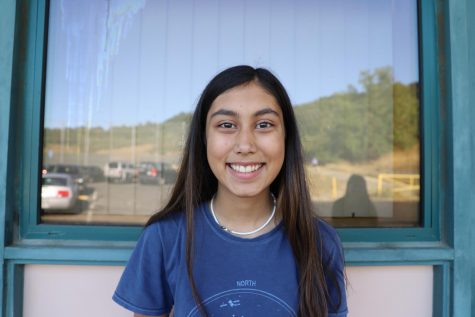Miramonte Graduates Create CMERA to Encourage Diversity in AUHSD
July 6, 2020
Millions are marching, holding signs, and shouting, “No justice no peace!” People are uniting to protest with the common goal of ending police brutality and systemic racism. Recent acts of brutality against people of color incited the outrage and push of the Black Lives Matter movement. Even in the small bubble of Lamorinda, residents are taking a stand against racism.
Two Miramonte High School graduates of 2019, Carly Johnson and Ava Killbourn, introduced The Committee for Multicultural Educational Reform in the Acalanes Union High School District (AUHSD) June 6 (CMERA). Their mission is to encourage diversity in the district and bring in the perspectives of people of color in the AUHSD curriculum. “We have been thinking about this for a year now. Originally, it started with just requesting that interdistrict transfers be reinstated, which we had discussed with some teachers at Miramonte. In light of the recent climate in AUHSD and nationally, we felt it pertinent to expand our goals to encompass diversification of the student body and of the curriculum,” Johnson and Killbourn said.
Johnson and Killbourn are not in this alone. Members of the team include 2020 graduates Amrita Pannu, co-founder and former president of the South Asian Culture Club, Nisha Andrews, and Keshini Cardozo. Along with rising senior, co-president of the Black Student Union, and Equiteam leader, Ava Moran.
Moran’s main focus is convincing the district to change their policy for transfer students. “My role in the committee is doing enough research to create a proposal that ultimately reverses the ban of inter-district transfers. Right now, I have to go through last years budget and this years proposed budget to figure out where money can be moved around, making enough space for at least 50 inter-district transfers. I am very passionate about this because I feel that interdistrict transfers bring a unique perspective to school,” Moran said.
Pannu focuses on the Human and Social Development curriculum and is working to make sure all students, no matter sexuality, feel safe and included on campus. “Racial issues do not exist in a vacuum, and we will do all we can to make sure that AUHSD supports and respects all its students regardless of race, sexuality, gender or socioeconomic status. Additionally, I will be working to bring guest speakers to educate students during academy sessions,” Pannu said.
Andrews is a co-chairperson of the committee and concentrates on implementing changes to the curriculum. Cardozo is working on the social studies curriculum reform and wants to add post 1960s racism and also wants students to learn more about civil rights figures like Malcom X.
“They have all taken such incredible initiative and we are beyond thankful they wanted to be a part of this project. Because these students are so heavily involved in Miramonte clubs and associations like the Black Student Union and the South Asian Culture Club, we have been very lucky to get involved with them as well,” Johnson and Killbourn said.
The committee believes that to fight the lack of diversity in the district, the curriculum should be addressed. With the overwhelming number of white authors as the core of the AUHSD English curriculum, the committee plans to reform these issues by requiring more texts written by non-caucasion authors to freshman and sophomore classes. The committee believes it is important to start with the underclassmen because they are more “impressionable.” The district already implemented a list of books in order to bring more diversity in 2019, and they plan to continue to add more. The committee is very pleased that the district addressed the need for the diversity in the curriculum.
According to Elizabeth Aracic, the English department chair, the following texts for freshman and sophomores were added:
Elizabeth Acevedo: Poet X
Chinua Achebe: Things Fall Apart
Chimamanda Ngozi Adichie: Purple Hibiscus
Rudolfo Anaya: Bless Me, Ultima
Maya Angelou: I Know Why the Caged Bird Sings
Sandra Cisneros: The House on Mango Street
Firoozeh Dumas: Funny in Farsi
Laura Esquivel: Like Water for Chocolate
Ernest Gaines: A Lesson Before Dying
Gandhi: His Life & Message for the World
Khaled Hosseini: The Kite Runner
Trevor Noah: Born a Crime
Marjane Satrapi: Persepolis
Gary Soto: Living Up the Street
Sonia Sotomayor: My Beloved World
Bryan Stevenson: Just Mercy
Amy Tan: The Joy Luck Club
Jeanne Wakatsuki: Farewell to Manzanar
Alice Walker: The Color Purple
Gene Luen Yang: American Born Chinese
Banana Yoshimoto: Kitchen
The following book list is for junior and seniors:
James Baldwin: The Fire Next Time
Ta-Nehisi Coates: Between the World and Me
Frederick Douglass: Narrative of the Life of Frederick Douglass
Ralph Ellison: Invisible Man
Lorraine Hansberry: Raisin in the Sun*
Zora Neale Hurston: Their Eyes Were Watching God*
Yasunari Kawabata: Snow Country
Jamaica Kincaid: A Small Place*
Maxine Hong Kingston: Tripmaster Monkey, Woman Warrior*
Toni Morrison: Beloved, The Bluest Eye, Song of Solomon, Sula*
Amy Tan: The Kitchen God’s Wife*
Tommy Orange: There There
Arundhati Roy: God of Small Things*
Zadie Smith: White Teeth*
Jesmyn Ward: The Fire This Time*
August Wilson: Fences
Richard Wright: Black Boy, Native Son
Collection: Arabian Nights and Days
Braided Lives Anthology
“By widening the scope of readings in the base-level English classes, our schools can give students a well-rounded understanding of literature. By implementing just a few books written by people of color in the earlier years of the English curriculum is an easy and effective solution,” Killbourn and Johnson said in their proposed solutions to racial issues in AUHSD.
Along with English classes, the committee believes that history classes also need to make a change. “We request that World History and Geography, United States History and AP United States History should give a unit of at least a week in length dedicated to teaching students about post-Jim Crow racism, the War on Drugs, mass incarcerations, police brutality, modern race relations and microaggressions. We understand that these are not simple issues to teach, and leave the specifics to the discretion of teachers in each department. We simply want to see our required history courses providing a holistic approach to the subject,” Johnson and Killbourn proposed.
The committee suggested the implementation of an annual freshman academy session to teach ways to oppose discrimination. “As you are likely aware, a number of videos of current and former students in the AUHSD system saying some abhorrent things have surfaced. Our educational system should not be instilling values that lead anyone to believe this is acceptable. Freshmen are particularly impressionable, and we should be encouraging a belief system that does not normalize discrimination,” Johnson and Killbourn said. The lesson plan is to have the freshman watch a TED talk given by a woman of color about intersectionality. The other part of the lesson is to have the students read an article about how to be more inclusive in everyday life. “We expect freshman teachers during one allotted academy period to watch the video with their class and then use the medium article to lead a discussion on tolerance and anti-discrimination practices. The plan is purposefully loose; we want students to genuinely engage with the material and have room to ask questions. By starting these conversations, we hope to create a community that stands up to discrimination without prompting,” Killbourn and Johnson said.
The committee plans to reform the transfer student policy. White students make up more than half of the student body in all four high schools in the district. “While it is understandable that the district wants to give its existing students the best possible education with the budget they are allocated, transfer students are an invaluable addition to the student bodies. Most of the students who attend these schools have lived in the Lamorinda and Walnut Creek area for the majority of their lives, and some are even multi-generational attendees of the schools,” Johnson and Killbourn said.
“I think our schools can only benefit from transfers, other than the money issue that the district cares about so much. They add much needed diversity and new perspectives that the Lamorinda bubble doesn’t often get to see,” transfer student and rising senior, Caitlin Smith said.
So far, the committee’s solutions are widely acknowledged and accepted across the district. “Teachers and administrators throughout the district have been very responsive and we are very thankful for that, but we do expect pushback and for some of our ambitions to be met with increasing skepticism,” Johnson and Killbourn said.
“The district has been very supportive of racial equity work; I have been encouraged by fellow teachers at every school, administrators at Miramonte, especially Julie Parks, and district administrators like Ms. McNamara,” English teacher Steve Poling said. Poling is teaching a new class, Deconstructing Race, starting in the 2020-2021 school year. “English teachers have been bringing in more texts written by women and POC for several years now. The new class, Deconstructing Race, is one of several steps our school and district has taken lately. My new class is less about mult-cultural literature, and more about racism, white supremacy and anti-racism. I’m encouraged by the work of CMERA,” Poling said.
“Right now, we have activated and enthusiastic allies and accomplices in this work. Racial equity is not a checkbox, it is constant, sustained work. The more people we have advocating and working toward making system level changes, the better we will do in transforming our school,” principal Julie Parks said.
June 30, the committee talked with superintendent, John Nickerson. The committee spoke to Nickerson about their key points: curriculum reform and inter-district transfer students. Nickerson gave the demographic makeup of teachers and transfer students and when the committee can start rolling out their plan. “We need to make progress on our teachers o of color. I’m sure some of you probably have had almost entirely white teachers, and we need our teachers to better reflect our student population. I know it’s absolutely inadequate, but we went from 10% to 14% last year. We need to get to at least 35% teachers of color,” Nickerson said. He sees a potential district wide transformation by next fall.
“We need more representation to raise the importance of burning problems related to race and ethnicity to open up different perspectives. This is one of the only ways we can transform from a racist society to a tolerant society, where color is not the cause of discrimination and where people live together on equal ground regardless of their racial or ethnic background,” rising senior Tahra Panah said.
Even graduates are supportive of the project. “The committee focuses on issues which I have seen all throughout my years of high school and I feel empowered as a person of color seeing that change is happening,” Las Lomas High School graduate of 2020 Harnoor Sidhu said.
“We want the school district to increase its diversity in both the student body and curricula and create an environment that is welcoming and accommodating. We would like to see content that is less focused on white contributions and instead reflects the multicultural reality of literature and history. We hope that these changes in education will help create a more accepting community,” Johnson and Killbourn said.








